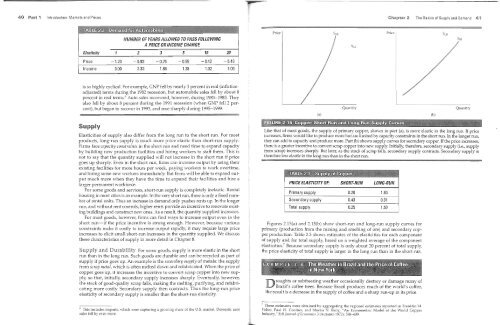Daniel l. Rubinfeld
Daniel l. Rubinfeld
Daniel l. Rubinfeld
You also want an ePaper? Increase the reach of your titles
YUMPU automatically turns print PDFs into web optimized ePapers that Google loves.
40 Part 1 Introduction: Markets and Prices<br />
Chapter 2 The Basics of Supply and Demand 41<br />
M %& §i &#§'<br />
Price<br />
Price<br />
NUMBER OF YEARS ALLOWED TO PASS FOLLOWING<br />
A PRICE OR INCOME CHANGE<br />
Elasticity<br />
2 3 5<br />
20<br />
Price -1.20<br />
Income 3.00<br />
-0.93 -0.75 -0.55 -0.42<br />
2.33 1.88 1.38 1.02<br />
- 0.40<br />
1.00<br />
is so highly cyclical. For example, GNP fell by nearly 3 percent in real (inflationadjusted)<br />
terms during the 1982 recession, but automobile sales fell by about 8<br />
percent in real terms. 6 Auto sales recovered, however, during 1983-1985. They<br />
also fell by about 8 percent during the 1991 recession (when GNP fell 2 percent),<br />
but began to recover in 1993, and rose sharply during 1995-1999.<br />
(a)<br />
Quantity<br />
(b)<br />
Quantity<br />
Supply<br />
Elasticities of supply also differ from the long run to the short run. For most<br />
products, long-run supply is much more price elastic than short-run supply:<br />
Firms face capacity constraints in the short rW1 and need time to expand capacity<br />
by building new production facilities and hiring workers to staff them. This is<br />
not to say that the quantity supplied will not increase in the short run if price<br />
goes up sharply. Even in the short run, firms can increase output by using their<br />
existing facilities for more hours per week, paying workers to work overtime,<br />
and hiring some new workers immediately. But firms will be able to expand output<br />
much more when they have the time to expand their facilities and hire a<br />
larger permanent workforce.<br />
For some goods and services, short-run supply is completely inelastic. Rental<br />
housing in most cities is an example. In the very short run, there is only a fixed number<br />
of rental units. Thus an increase in demand only pushes rents up. In the longer<br />
run, and without rent conh"Ols, higher rents provide an incentive to renovate existing<br />
buildings and construct new ones. As a result, the quantity supplied increases.<br />
For most goods, however, firms can find ways to increase output even in the<br />
short run-if the price incentive is strong enough. However, because various<br />
constraints make it costly to increase output rapidly, it may require large price<br />
increases to elicit small short-run increases in the quantity supplied. We discuss<br />
these characteristics of supply in more detail in Chapter 8.<br />
Supply<br />
For some goods, supply is more elastic in the short<br />
nm than in the long run. Such goods are durable and can be recycled as part of<br />
supply if price goes up. An example is the secolldary supply of metals: the supply<br />
from scrap metal, which is often melted down and refabricated. When the price of<br />
copper goes up, it increases the incentive to convert scrap copper into new supply,<br />
so that, initially, secondary supply increases sharply. Eventually, however,<br />
the stock of good-quality scrap falls, making the melting, purifying, and refabricating<br />
more costly. Secondary supply then contracts. Thus the long-run price<br />
elasticity of secondary supply is smaller than the short-rwl elasticity.<br />
6 This includes imports, which were capturing a growing share of the Us. market Domestic auto<br />
sales fell by even more.<br />
Like that of most goods, the supply of primary copper, shown in part (a), is more elastic in the long nm. If price<br />
increases, firms would like to produce more but are limited by capacity constraints in the short run. In the longer run,<br />
they can add to capacity and produce more. Part (b) shows supply curves for secondary copper. If the price increases,<br />
there is a greater incentive to convert scrap copper into new supply. Initially, therefore, secondary supply (i.e., supply<br />
from scrap) increases But later, as the stock of scrap falls, secondary supply contracts. Secondary supply is<br />
therefore less elastic in run than in the short run.<br />
PRICE ELASTICITY OF: SHORT-RUN LONG-RUN<br />
Primary supply 0.20 1.60<br />
Secondary supply 0.43 0.31<br />
Total supply 0.25 1.50<br />
Figures 2.15(a) and 2.15(b) show short-run and long-run supply curves for<br />
primary (production from the mining and smelting of ore) and secondary copper<br />
production. Table 2.3 shows estimates of the elasticities for each component<br />
of supply and for total supply, based on a weighted average of the component<br />
elasticities.! Because secondary supply is only about 20 percent of total supply,<br />
the price elasticity of total supply is larger in the long run than in the short run.<br />
Droughts or subfreezing weather occasionally desh·oy or damage many of<br />
Brazil's coffee h·ees. Because Brazil produces much of the world's coffee,<br />
the result is a decrease in the supply of coffee and a sharp run-up in its price.<br />
7 These estimates were obtained by aggregating the regional estimates reported in Franklin M<br />
Fisher, Paul R Cootner, and Martin N. Baily, "An Econometric Model of the World Copper<br />
Industry," Bell JOllrnal of Ecollolllics 3 (Autumn 1972): 568-609.

















